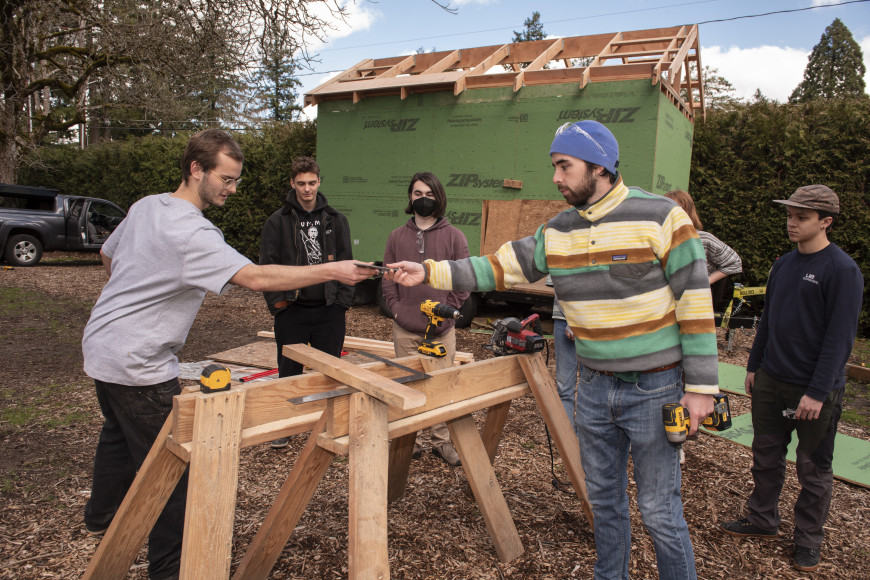Tiny House Emerges From Big Vision

by Hanna Merzbach BA ’20
The popularity of tiny homes has skyrocketed in recent years. But they’re more than a fad—building small is one of the greenest ways to build a home. That’s one of the reasons two Lewis & Clark students founded the Tiny House Club, which is focused on creating a sustainable dwelling to donate to a nonprofit in the greater Portland community.
The club’s cofounders, Elijah Black BA ’23 (an economics major) and Mari Johnson BA ’22 (a physics major), both have an affinity for carpentry and the tiny-home lifestyle. While Lewis & Clark offers students the opportunity to work with wood in both sculpture and theatre classes, Black and Johnson wanted to learn more about construction.

“It’s an opportunity to learn hands-on skills,” Black added.
So far, about 35 students have attended the club’s building days, which they hold a couple of times a week. For Black and Johnson, the most rewarding part is teaching other students how to build and seeing them discover a new passion.
“We’ve had people who didn’t know how to use a drill or a hammer and nail, and now they’re teaching other students,” Johnson said. “I hope our members continue to use their skills on projects they want to build themselves.”
Right now, the club’s focus is on a single tiny home, a 8- by 16-foot wood structure that sits atop a trailer on the graduate school campus. This location is temporary though, as the club plans on donating the house to Community Vision, a local nonprofit that finds housing solutions for people living with disabilities.
The tiny home will eventually end up as an additional dwelling unit (ADU) in someone’s backyard, according to Black.

Giving the house to a local nonprofit means L&C doesn’t need to worry about maintaining it in the future—and, more importantly, it means someone is sure to make good use of it. Throughout the process, both L&C students and staff have been “very pro-tiny house,” Black and Johnson said. Staff across campus—from the Offices of Facilities and Sustainability to Annual Giving and Student Engagement—have rallied to bring the Tiny House club to fruition. Even Alice Wiewel, wife of President Wim Wiewel, was on board and advocated for the club.
Amy Dvorak, senior director of sustainability and communications, said she first heard of the Tiny House Club when teaching her Sustainability and Entrepreneurship course. She interrupted her lecture to learn more.
“This is truly a unique club at L&C,” Dvorak said. “It brings together students with an interest in sustainability and alternative building who also have a desire to develop their hands-on skills.”
Ultimately, the club received $16,500 in funding (from student fees) to build the structure. In the 2022–23 funding round, they hope to get the rest of the funds necessary to work on the inside of the house, installing recycled wood countertops, a loft-bed platform, and a private bathroom. The goal is to finish the home by the end of 2022, although that date is flexible.
“The completion date is dependent on how much time we can spend building, who comes, how much teaching we’re doing, and whether things go wrong,” Johnson said. “It would be different if we had all done this before, but it’s not that linear.”
Luckily, club members can draw on the in-house carpentry knowledge of facilities staff, like Adam Ferrel, the school’s lead carpenter, who has supervised the building for months. David Ernevad, associate vice president for facilities, has also supported the club, saying it’s an exceptional way for students to learn how to manage projects and work with their hands.
“It’s creative, yet logical, requiring lots of critical thinking, resulting in a highly tangible outcome of a habitable home,” Ernevad said. “The mission of donating the completed tiny home to locals in need further amplifies the good that comes from this club’s work.”
The club plans on using its newfound carpentry talent to help other clubs and areas of campus. The students have already partnered with the L&C Garden Collective to build a Little Free Library. The club also plans on holding a screen-printing workshop (with screen structures Johnson made herself) and helping the Office of Sustainability create a reuse space for students to donate their old belongings.
It’s unclear who will take over the club once Johnson and Black graduate, but they are proud to have set the precedent for a building-focused club at L&C. And one other thing is certain: After this project, Black and Johnson are only more determined to build and live in their own tiny homes.
According to Black, “I don’t see myself living in anything else.”
Read more about Tiny House Club in The Oregonian
Sustainability Sustainability Office
Tiny House Club






Related Content
More Stories

National Award
Finn Watson BA ’26 Wins Goldwater Scholarship
Watson is one of 441 students selected from a pool of more than 5,000 nationwide for the Barry Goldwater Scholarship, the preeminent award for undergraduates in the natural sciences, engineering, and mathematics.

New Leadership
Andrew Saultz Selected Dean of the Graduate School
Andrew Saultz, an alumnus of L&C’s Master of Arts in Teaching program, begins his tenure on August 4.

Stronger Together
Lewis & Clark and Albina Vision Trust Launch Historic Partnership
The new collaboration will build a hub for education and economic opportunity within Portland’s redeveloped Lower Albina district to foster learning as a core value of the community and provide opportunities for Albina residents and Lewis & Clark students, staff, and faculty.

Big Winners
Speech and Debate Shines at National Tournaments
Lewis & Clark’s speech and debate program won a pair of championships at recent national tournaments. The team of Maltin Tocani BA ’25 and Isabella Moore BA ’26 won the Honors division at the YODL national British Parliamentary debate championships, while the Lewis & Clark contingent at the National Speech Tournament won the team title in the limited entry category.

